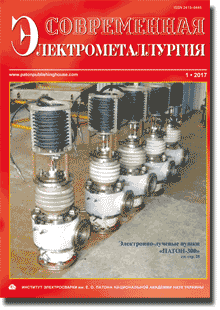| 2017 №01 (04) |
DOI of Article 10.15407/sem2017.01.05 |
2017 №01 (06) |

Electrometallurgy Today (Sovremennaya Elektrometallurgiya), 2017, #1, 29-34 pages
Surface oxidation of molten metal in the process of dispersing in IMSM
Kalashnik D.A., Shapovalov V.A., Nikitenko Yu.A., Kozhemyakin V.G.
E.O. Paton Electric Welding Institute, NASU. 11 Kazimir Malevich Str., 03680, Kiev, Ukraine. E-mail: office@paton.kiev.ua
Owing to their unique properties (mechanical, electric, magnetic, etc.) the rapidly-hardened materials find application in many branches of industry. One of the promising methods of producing these materials is the dispersion from melt during induction melting in a sectional mould. One of the peculiarities of this method is the formation of an oxide film on the surface of molten metal, which can prevent the normal running of the process. The problem of occurrence of oxide films on the metal pool surface during induction melting in a sectional mould was investigated. The refractory films are especially often used in dispersion of alloys, containing highly-active metals. In the work the methods of elimination of oxide films are analyzed: hydrogen recovery, recovery using more active metals, dissolution of film in the fusible slag, etc. The method was selected on the example of magnetic hard alloy UND 8, which includes the active components. It was suggested to apply the slag for leveling the negative effect of oxide films on the surface of alloy UND 8. For the further application the salt slags were recommended, having no oxygen in their composition. The process of dissolution of oxide films in applying lithium–potassium–fluoric slag was analyzed. Ref.11, Tables 4, Figures 2.
Keywords: dispersion from melt; magnetic alloys; slag; flakes; induction melting in a sectional mould; rapidly-hardened metals
References
1. Kalashnik D.A., Shapovalov V.A., Sheiko I.V., Nikitenko Yu.A., Yakusha V.V. (2015) Analysis of technological peculiarities of producing rapidhardening alloys (Review). Sovremennaya elektrometallurgiya, 3, 27-34. https://doi.org/10.15407/sem2015.03.052. Kalashnik D.A., Nikitenko Yu.A., Shapovalov V.A., Sheiko I.V., Kozhemyakin V.G., Veretilnik A.V. (2016) Shape and geometric sizes of rapid-hardening materials produced by dispersion from melt in IMSM. Sovremennaya elektrometallurgiya, 3, 31-34. https://doi.org/10.15407/sem2016.03.06
3. Shapovalov V. A., Sheyko I. V., Nikitenko Yu. A. (2009) Polucheniye bystrozakalennykh splavov sposobom dispergirovaniya pri IPSK. Sovremennaya elektrometallurgiya, 3, 32-35.
4. Grigorenko G. M., Sheyko I. V. Induktsionnaya plavka metallov v kholodnykh tiglyakh i okhlazhdayemykh sektsionnykh kristallizatorakh.- K.: Stal, 2006.- 320 s.
5. Elektronno-luchevaya plavka / B. E. Paton i dr.- K.: Nauk. dumka, 1997.- 267 s.
6. Yagodin G. A., Sinegribova O. A., Chekmarev A. M. Tekhnologiya redkikh matallov v atomnoy tekhnike: ucheb. pos. dlya vuzov; pod red. B. V. Gromova.- M.: Atomizdat, 1974.- 344 s.
7. Lakomsky V. I. Vzaimodeystviye diatomnykh gazov s zhidkimi metallami pri visokikh temperaturakh.- K.: Nauk. dumka, 1992.- 232 s.
8. Petrunin I. Ye., Lotsmanov S. N., Nikolayev G. A. Payka metallov.- K.: Metallurgiya, 1973.- 280 s.
9. Podgayetsky V. V., Kuzmenko V. G. Svarochnye shlaki. Spravochnoye posobiye.- K.: Nauk. dumka, 1988.- 251 s.
10. Roake W. E. (1957) The systems CaF2-LiF and CaF2-LiF-MgF2. J. of the electrochemical society, 11, 661-662. https://doi.org/10.1149/1.2428441
11. Diagrammy plavkosti solevykh sistem. Troynye sistemy; pod. red. V. I. Posypayko, Ye. A. Alekseyevoy.- M.: Khimiya, 1977.- 328 s.
